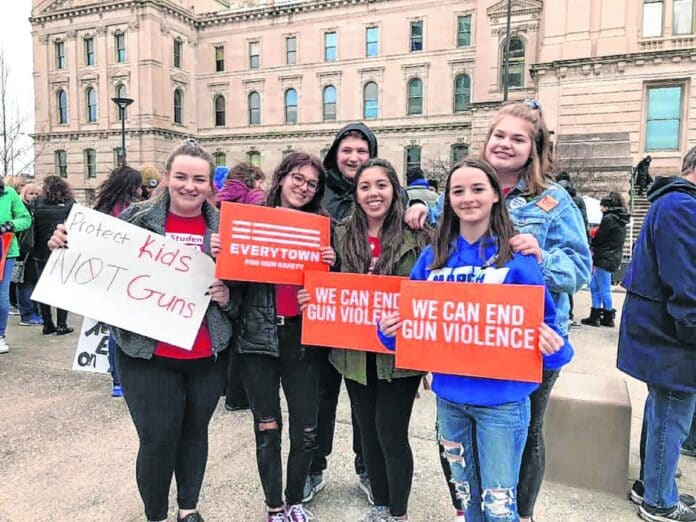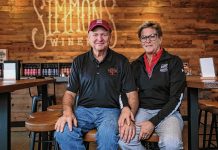
NOBLESVILLE — The first “Code Yellow” announcement over the intercom wasn’t enough to startle the students in Carly Chier’s psychology classroom at Noblesville High School on May 25, 2018.
This wasn’t the first time the school had gone on a code yellow, a situation in which no one is allowed to enter or exit the school building. Normal classroom activity continues.
“Immediately for me, my brain tends to go into the worst-case scenario,” Chier said, recalling the morning, second-by-second. “A lot of my classmates thought someone escaped from jail — our school is right across from the jail — and that has happened before.”
A Noblesville High School administrator’s voice echoed over the intercom again, about 30 minutes after the original warning. The warning was updated to a code orange, requiring students to stay in their classrooms with their teachers.
[sc:text-divider text-divider-title=”Story continues below gallery” ]
Chier and her classmates started raising their own suspicions.
“My brain went to, ‘Which school is it?’” Chier said.
About 30 minutes later — around 10:25 a.m. — a code red was called. A code red means there is an imminent danger and protective action is needed. This involves teachers and students assuming a protective position in their classrooms until instructions are given.
Chier texted her mother, “I love you,” not knowing if she would make it home from school that day.
Growing up, Chier said she had always been reserved. She was never one to voice how she felt.
That was until the unthinkable occurred in her hometown of Noblesville, Indiana — a city on the northeast side of the Hoosier state where just under 62,000 people reside.
On May 25, 2018, at about 9:07 a.m., a Noblesville West Middle School student opened fire in science teacher Jason Seaman’s classroom, injuring Seaman and 13-year-old Ella Whistler.
“Everything from that day is super vivid to me, but also doesn’t seem like it happened,” Chier said.
Chier said she vividly remembers a classmate looking at her phone and gasping. Another classmate received a call from his little sister, a student at Noblesville West, who was screaming on the other end. Chier can still hear the terror in the young girl’s voice.
“It was petrifying,” Chier said. “I’ve thought about that phone call once a week.”
Shortly after the incident at Noblesville West, the high school was also believed to be under a threat. As Chier texted her family about her whereabouts and said she loved them, she and her classmates sat in the corner of their classroom — the door barricaded by desks and chairs to prevent anyone from entering the room.
Not an ordinary day
May 25, 2018, started as an ordinary day for most, but Nolan Weaver remembers it as anything but that.
A then-eighth-grade student at Noblesville West, Weaver served on the student technology team where he worked closely with the school’s technology director. On May 25, 2018, students were scheduled to turn in their iPads to the technology department where a station had been set up near the science division hallway.
That morning, Weaver helped the department collect iPads and was called down to the main office for a meeting with his school counselor.
“I didn’t know why I was down there,” Weaver said, recalling his every move that morning.
While sitting in a school conference room with his counselor, a Noblesville West administrator’s voice rang over the intercom, “This is not a drill. There is an active shooter in the seventh-grade hallway.”
“I remember standing up with my hands on my head,” Weaver said. “I couldn’t see my face, but I could feel the fear through my body. It was the scariest thing I’ve been through.”
Just one week before, Weaver sat in his math class when an Apple News alert was blasted on the projector — “Multiple dead in Texas high school shooting.” Weaver said students in his classroom gasped as his teacher reassured them that nothing like that would ever happen to them.
“It proved no one is safe,” Weaver said.
Any time the intercom rings throughout the school building, Chier said she tenses up.
When he hears a book drop or a loud noise, Weaver replays the details of May 25, 2018, in his mind.
“It had come to the point where I couldn’t ignore the problem anymore,” Chier said. “I was acknowledging the problems that happened in other schools, but I didn’t do anything to help until it happened to us. We weren’t invisible anymore.”
Getting involved
Chier started to seek ways she could get involved to make schools across the country safer. A group of Noblesville students tried to schedule a Skype call with students from Marjory Stoneman Douglas High School in Parkland, Florida, where 17 people were killed and 17 others wounded after a former student opened fire inside the school.
“The fact that it had hit so close to home; that it wasn’t something you just saw on Twitter and it was gone a few days later, I wanted to make sure it didn’t happen again,” Chier said. “I walked through those halls. I know that school like the back of my hands.”
That’s when Let’s Talk Change developed. Let’s Talk Change started as a group of Noblesville student activists, then it transitioned into a Students Demand Action chapter earlier this year. Chier said it’s simply a way for students’ voices to be heard.
Chier traveled to Washington, D.C., in October for a two-day conference on gun violence created for students by students. Chier had a hand in organizing the event.
“It was the most amazing thing I’ve ever experienced,” Chier said.
The conference was filled with various workshops, networking opportunities and panels ranging from survivors of gun violence to leaders of movements like March for Our Lives. The most impactful moment, Chier recalled, was seeing nearly everyone’s hands in the room raise when asked if they or someone they knew had been impacted by gun violence.
“You don’t have to be a survivor to fight against gun violence because it affects everybody,” she said.
After the summit, Chier and her classmates started to actively lobby for gun control. This February, members of the group, including Chier and Weaver, faced lawmakers with tough questions and information in an effort to sway their votes toward more control.
Weaver said he was initially nervous to join the group because he wasn’t familiar with anyone but has since found a family in Students Demand Action.
“We all have a common goal: To decrease gun violence,” Weaver said.




